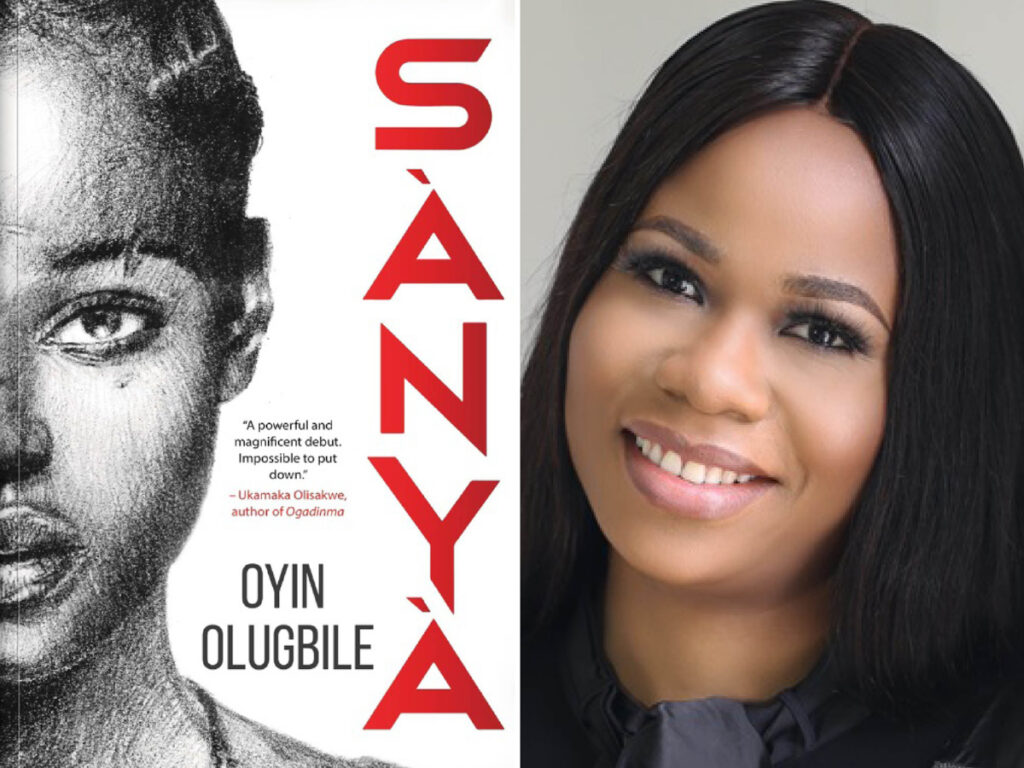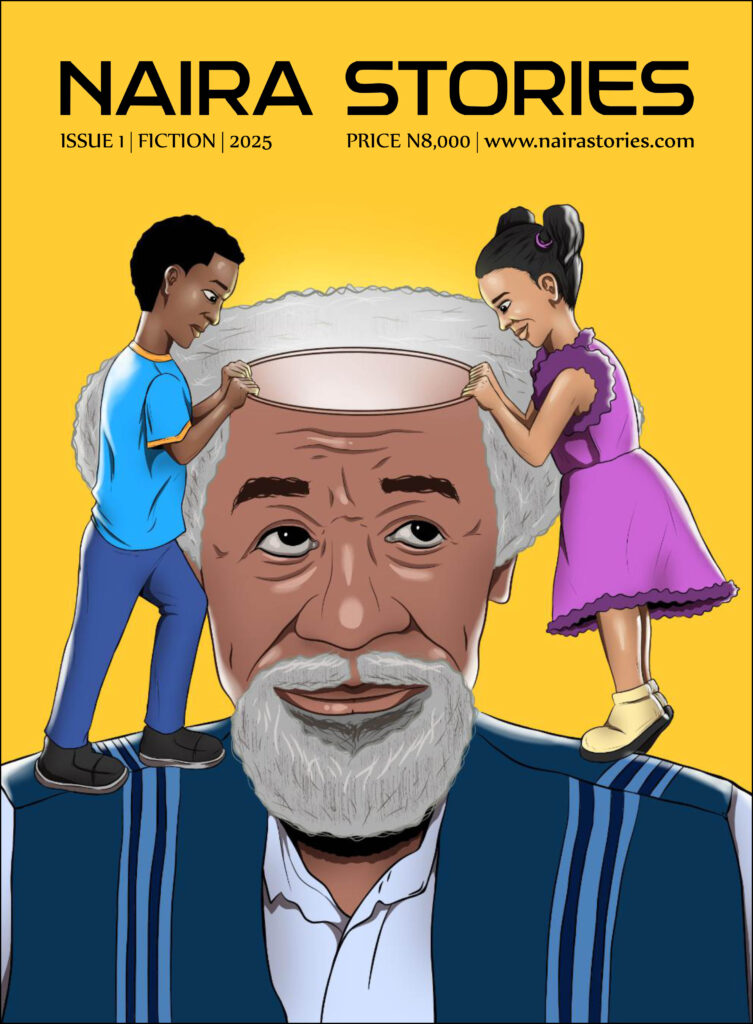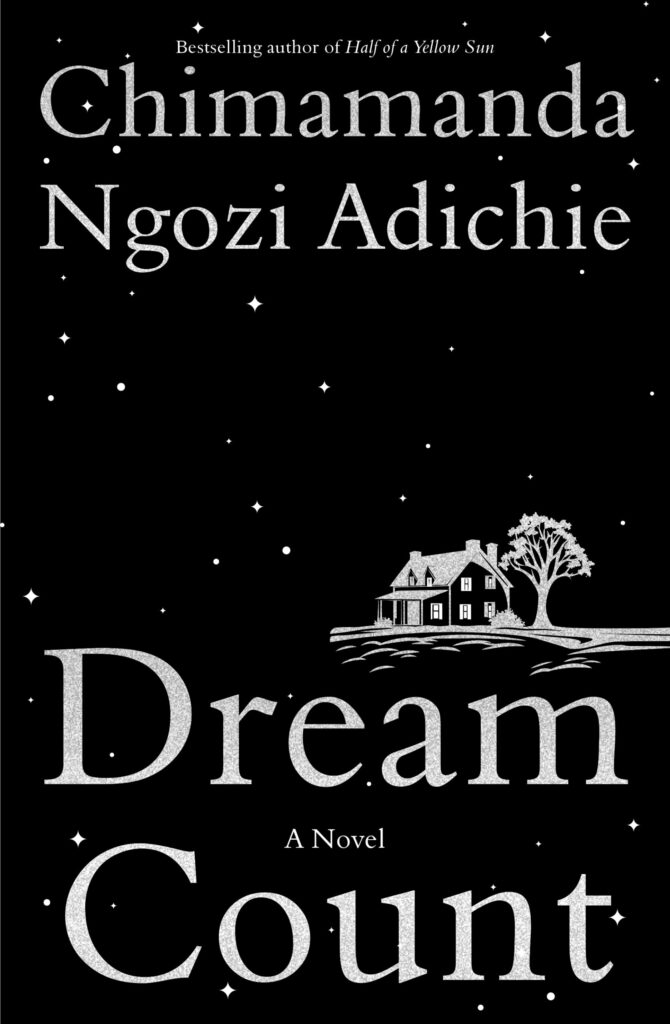I once spent an afternoon at Iyanoba, skimming through the collection of those people who sell books on the ground. They would pick one open space, arrange the books on the ground, the kind where the books lean against each other like tired commuters on a danfo. The owner, a man who claimed to have read everything worth reading, told me: “The problem with our stories is we are always trying to prove something to the world, to ourselves, to our ancestors. The best stories forget all that and just are.”
I thought about him while reading Sanya.
The book opens not with action but with accounting — a mythological ledger of Orisa and sorcerers, divine order and rebellious magic. This prologue announces its ambitions loudly, like a trader at Balogun Market. And ambition is what Sanya has in abundance: it seeks to resurrect Yoruba cosmology for the fantasy genre, to interrogate gender and power, to be both an intimate family drama and an epic war chronicle, and to matter. Sometimes, it succeeds.
Across five parts — Stemma, Chrysalid, Imperium, Hubris, and Alarum — the narrative follows Sanya and Dada, siblings whose destinies were written in divine ink before they were born. Sanya becomes a warrior-king by concealing her womanhood; Dada becomes a king by embracing darkness. Between them: grief, jealousy, love, and the kind of betrayal that only family can perfect. The Orisa move through the narrative like heat shimmer — sometimes clear, sometimes distorted, but always present.
What works best is the emotional geology, the layers of hurt and hope compressed over time until they become something hard and sharp. When Àjoke loses child after child, when Dada watches his sister’s shadow swallow his own achievements, when Sanya realises her brother has become her enemy — these moments land because they are universal even when wrapped in the particular cloth of Yoruba cosmology.
The sibling bond is the book’s spine. Their relationship is rendered with painful authenticity: Sanya’s fierce protectiveness that Dada experiences as humiliation, Dada’s intellectual gifts overshadowed by his sister’s physical prowess, the way love and resentment can occupy the same heart simultaneously. This is the tragedy of family, that the people who know us best can wound us deepest, and that protection can be indistinguishable from suffocation.
Here is where we must speak plainly: Sanya suffers from what kills many promising manuscripts — the inability to let go. The book is overstuffed like a market bag after December shopping, bulging with repetitions that do not deepen meaning but instead dull it.
Consider how grief is handled. When Àjoke loses her children, we are told about her despair. Then, told again from another angle. Then referenced in later chapters. The same pattern afflicts battle scenes — warriors marked with osùn, torches lit, enemies scattered — described in near-identical terms across multiple chapters until the imagery loses its power to move us.
In Chapter 1, the backstory of Àjoke and Aganjú’s courtship is “long-winded and slows the pacing.” Chapter 2 continues this pattern, backtracking “into long retellings of stillbirths” that “feel repetitive after Chapter 1’s focus on similar losses,” risking “emotional fatigue for readers.” By Chapter 3, we encounter “repetition of grief” where “prolonged descriptions of weeping, despair, and decline are revisited in slightly different words,” threatening to numb rather than move.
This is structural indiscipline masquerading as thoroughness. A writer who trusts their reader shows grief once with precision and lets it reverberate. A writer who does not trust their reader shows it five times, each iteration diluting the original impact.
The battle scenes suffer similarly. Chapter 10’s raid is “dynamic and cinematic,” but subsequent battles in Chapters 21, 23, and 26 recycle the same choreography: night attack, osùn-marked warriors, torches, supernatural fire, enemy scatter. By the fifth iteration, what should be climactic feels routine.
This is what happens when a writer confuses length with depth. The book runs to what feels like 400+ pages when a ruthless edit could have delivered the same emotional arc in 280. Every subplot stretched past its natural end, every emotion examined from multiple angles when one sharp cut would suffice.
The book’s relationship with women is more complex than simple critique allows, revealing both genuine insight and missed opportunities. Sanya herself is compelling — a woman who becomes king not through magic disguise but through skill, courage, and the terrible discipline of self-erasure. Her arc interrogates what power costs when it requires denying your fundamental self.
The Obatooni-Osuntóke dynamic deserves careful reading. These are not simply beautiful sisters competing for male attention. Obatooni enters a celibate political marriage to protect both her secret vow to the gods and Sanya’s secret sex. She later takes a lover (Ok), not from mere passion but from a life constrained by duty and deception. Osuntóke is given as the second wife specifically to produce an heir, then strategically ignored. Her humiliation is both romantic and political. When she poisons her sister, it is driven by childhood wounds about their father’s favour, legitimate anger at being instrumentalised, and naked political ambition to secure the throne and bear the heir Obatooni cannot.
The text gives both sisters agency, complexity, and understandable motivations. Their tragedy is not that they are catty women fighting over a man — it is that they are trapped in a system where marriage and childbearing are the only routes to power, and where sisterhood becomes impossible under the weight of patriarchal expectations. This is actually sophisticated political drama.
The problem emerges in execution rather than conception. Both sisters are introduced through extensive physical descriptions emphasising their beauty, before we learn their characters. The prose lingers on faces, bodies, and adornment in ways that risk reducing them to objects of aesthetic appreciation. When the narrative does explore their interior lives and political calculations, it is often in scenes still framed by romantic or sexual dynamics.
The pattern varies with other female characters. Àbiké is developed as a “complicated guardian — nurturing, firm, but also hiding secrets” about Sanya’s destiny and her own sacrifices. She is more than a caretaker, though the narrative sometimes treats her primarily in relation to the children she raises. Oya begins as Sanya’s divine guardian but reveals herself as a goddess with her own agenda, reclaiming what was stolen from her. By Chapter 31, she makes a profound choice to release Sanya’s trapped fire into the world as a wandering spirit, an act of sacrifice that costs her the divine child she carried.
Sanya’s friends in Chapter 6 reveal the book’s uneven treatment of the female community. At the washing stream, Sanya dances, confides her secret feelings for Osóòsi to her close friends Rónké and Kánmi, and discusses womanhood and marriage expectations. These are genuine friendships with real intimacy. When Kánmi jokingly insults Dada, triggering Sanya’s fierce protectiveness, the conflict reveals layered character dynamics — not backdrop, but real relationships with tension and love intertwined. Yet even here, the scene primarily serves Sanya’s arc, and these friends largely disappear from the narrative afterwards.
The book gestures toward feminist subversion through Sanya’s gender disguise and martial prowess, and it does achieve moments of genuine insight about the costs of female power in patriarchal systems. But it also falls into patterns where women who do not claim masculine power remain largely defined by beauty, romance, and their relationships to men. The implicit message becomes muddled: women can transcend these limitations, but only by abandoning womanhood itself.
Contemporary Nigerian writers like Chimamanda Ngozi Adichie in Half of a Yellow Sun and Sefi Atta in Everything Good Will Come depict patriarchal societies without reducing women to their romantic and marital roles. Sanya attempts this complexity but does not fully achieve it. The vision is there, but the prose habits undermine it.
Structure reveals intention, and Sanya‘s structure reveals a writer still learning to shape narrative time. The five-part division suggests deliberate architecture: birth and origin (Stemma), transformation (Chrysalid), rise to power (Imperium), downfall (Hubris), and chaos (Alarum). It is the skeleton of Greek tragedy grafted onto the Yoruba epic.
But the flesh does not quite fit the bones. Stemma drowns in backstory across its three chapters before Sanya’s actual journey begins. We learn about Àjoke and Aganjú’s courtship in exhaustive detail, revisit Dada’s childhood illness multiple times, and receive lengthy explanations of family dynamics that could have been shown through action. The first sixty-odd pages are almost entirely exposition, necessary context delivered with insufficient drama.
Yet the prologue itself is not without merit. It establishes a “rich mythological foundation” with “clear thematic stakes,” provides “atmospheric world-building” with imagery of “cracked earth, parched skies, and thunderous battles,” and introduces “moral ambiguity” through Èṣù’s legitimate grievance about recognition. The problem is not that it lacks substance. Rather, it is that it is “exposition-heavy” and tells us “about events rather than” immersing us in them. The mythology is sound; the delivery is inert.
Chrysalid and Imperium fare better, moving with purpose through Sanya’s transformation and rise. But Hubris becomes structurally unwieldy. Chapter 22 alone contains Obatooni’s illness, the sisters’ confrontation, poisoning revealed, Sanya’s secret exposed, and Osuntóke’s murder — five climaxes stacked atop each other until the reader has no space to process any single revelation before the next arrives. This is the narrative equivalent of serving all five courses simultaneously.
Alarum suffers the opposite problem: rushing. Chapter 29 compresses what should be three chapters — prophecy, invasion, battle, deaths, revelations — into one breathless sequence. Chapter 31 speeds from Sanya’s despair to a suicide attempt to fire-spirit release in rapid succession, each moment deserving more room to breathe.
The book needed an editor willing to redistribute its weight. Compress Stemma to one tight chapter of essential backstory. Let Hubris unspool its revelations across more space. Give Alarum the room its apocalyptic stakes demand. The story is strong enough to survive this surgery; indeed, it would only become stronger.
Dialogue is where prose reveals its discipline, and Sanya‘s dialogue too often lacks that discipline. Characters speak in speeches rather than conversation, announcing their feelings and backstories with the subtlety of news broadcasts.
In Chapter 13, Dada reflects internally: “I am King now. A ruler of a prosperous village. I have wealth, power, and the adoration of my people.” This is telling masquerading as thought. In Chapter 25, Dada and Sanya’s reunion devolves into an exposition exchange where each recounts their rise to power in neat summary paragraphs, dialogue written not for the characters but for readers who need catching up.
Compare this to how contemporary African writers handle similar challenges. In Chigozie Obioma’s The Fishermen, brothers communicate in fragments and silences, their relationship revealed through what they do not say as much as what they do. In Akwaeke Emezi’s The Death of Vivek Oji, identity and secrets emerge obliquely, through accumulated detail rather than declaration.
The book’s prose also struggles with consistency. It can produce genuinely striking images: Sanya cutting her bridal cornrows in the forest, Oya emerging from water clothed in light, Dada’s throne room quaking under divine anger. But these moments are surrounded by passages that overwrite, that explain when they should suggest, that tell us three times what needed to be said once.
Chapter 7 exemplifies this: Sanya’s dread about marriage to Adéolú is described, then described again in slightly different terms, then referenced in her internal monologue, then shown through her avoidance of training. The reader understands her dread the first time; repetition does not deepen it, it only dilutes it.
There is a particular challenge facing Nigerian writers working with indigenous mythology in the fantasy genre: how to honour the source material without either exoticising it for Western audiences or over-explaining it for local ones. This is the tightrope Amos Tutuola walked in The Palm-Wine Drinkard, that Ben Okri navigated in The Famished Road, that Tomi Adeyemi confronts in Children of Blood and Bone.
Sanya understands the importance of this balance but does not always achieve it. The prologue, despite its mythological richness and atmospheric world-building, reads as more primer than drama. It tells us about Orisa and sorcerers rather than showing us their conflict through action or character. This is the expatriate’s dilemma: the anxiety that readers would not understand, leading to preemptive explanation that undercuts the very mystery that makes mythology powerful.
Contrast this with how the book handles mythology when it trusts itself. Oya’s emergence from the Olúweri stream in Chapter 17 needs no preamble or explanation. She simply appears, radiant and terrible, and we understand through imagery rather than exposition. The garden of creation in Chapter 19, with its shape-shifting pelépe and fountain of immortality, invites us into wonder without pausing to define terms. These moments show what the book is capable of when it stops trying to prove itself and simply is.
The book also grapples with how to present cultural specifics, such as names, terms, and concepts, to a potentially unfamiliar audience. Sometimes it succeeds: osùn markings for warriors, the significance of being born with locs, the ritual weight of bride-price gifts. These details accumulate into lived-in authenticity. But other times, the text pauses mid-scene to explain what a reader could infer from context, breaking immersion for the sake of clarity that was not needed.
Contemporary Nigerian fantasy is developing its own aesthetic language, one that neither panders to Western readers nor assumes exclusively local knowledge. Nnedi Okorafor’s Akata Witch demonstrates this balance, offering “a vibrant and immersive magical world rooted in Yoruba traditions” while remaining accessible. Sanya is feeling toward this same balance but has not quite found it yet.
Despite these structural and stylistic struggles, Sanya achieves something genuinely difficult: it makes the sibling tragedy feel inevitable without feeling predetermined. This is the hardest trick in tragedy — creating the sense that events could not have unfolded otherwise while preserving the characters’ agency and moral complexity.
The book earns this through patient accumulation. Dada’s jealousy does not appear suddenly. It is planted in childhood when Sanya defends him from bullies, and he feels both grateful and humiliated. It grows when she succeeds at the masculine arts that he is being taught to value while his own gifts — intelligence, craft, and strategy — are dismissed as inadequate compensation for his frailty. It deepens when their aunt dies, and he is alone with his inadequacy. It festers when chiefs offer him a throne he did not earn through martial prowess. And it finally corrupts when he watches his sister become beloved in his own kingdom, rendering his achievements invisible.
Each step is psychologically credible. Dada is not a villain by nature but by circumstance and choice — the realistic kind of villain, the one we can understand even as we condemn. Èṣù’s voice does not create his darkness; it names and empowers what was already there.
Sanya’s arc mirrors this inevitability. Her protective instincts toward Dada are not wrong, but they become suffocating. Her decision to make Bániré part of her confederation is not malicious, but it is thoughtless. She is so accustomed to being the solution that she does not consider she might be the problem. Her assumption that Dada will simply accept her help reveals how her power has blinded her to the dignity of others’ autonomy.
The tragedy works because both siblings are right and both are wrong. Dada has legitimate grievances; his resentment is not merely petty jealousy. Sanya has genuine protective impulses; her actions are not purely self-aggrandising. The gap between intention and impact yawns wide enough to swallow a kingdom.
There is also the quieter tragedy of guilt misplaced and truth delayed. In Chapter 7, Sanya kills Rópò, the childhood bully, with his own hoe and flees, believing herself a murderer. This guilt haunts her for years, shaping her self-perception and her fear of her own violence. Only in Chapter 24 does Osóòsi reveal the truth: Rópò survived. The relief this brings is profound but temporary. By Chapter 26, Sanya actually does kill him when he reappears as the bandit leader threatening Bániré.
The book understands that sometimes we carry guilt for crimes we did not commit, only to later commit them after all. Destiny and choice blur in ways that feel psychologically true.
This is what carries the book through its structural struggles: the emotional architecture is sound. When Dada and Sanya face each other across a battlefield in Chapter 29, when Osóòsi dies defending Sanya in that same battle, when Sanya attempts suicide in Chapter 31, and Oya releases Sanya’s trapped fire into the world — these moments land with genuine force because they have been properly built. The foundation supports the weight.
So we arrive at the central question: is Sanya a successful book?
The answer depends on what we are measuring. As an act of cultural reclamation, embedding Yoruba cosmology in epic fantasy, it succeeds more often than it fails. The Orisa feel real, not window-dressing. The spiritual logic of the world is internally consistent. The integration of divine politics with human drama creates genuine stakes at multiple scales.
As a family tragedy, it succeeds powerfully. The sibling relationship is the book’s heart, and that heart beats true. The love between Sanya and Dada, the way protection curdles into resentment, the inevitability of their conflict — this is a tragedy that earns its tears.
As a meditation on power and gender, it succeeds partially. Sanya’s double life as a woman-king creates genuine tension and insight. The Obatooni-Osuntóke conflict is more sophisticated than a simple rivalry. But the prose habits — extensive beauty descriptions, framing female agency through romance and marriage — undermine some of the thematic complexity the plot achieves.
As a work of prose craft, it struggles. The repetition, the overwriting, the exposition-heavy dialogue, the structural imbalances — these are not minor issues but fundamental ones that prevent the book from achieving the full power its story deserves.
And yet. There is something to be said for ambition itself, for the willingness to attempt epic scope and tragic depth even imperfectly. There is something admirable about a writer who trusts Yoruba mythology enough to centre it without apology, who tackles complex moral questions without easy answers, who is willing to let beloved characters destroy each other in service of emotional truth.
The book needed a more ruthless editor, someone willing to cut fifty pages from Stemma, compress repeated battle descriptions, trim redundant emotional beats, and redistribute the climaxes of Hubris and Alarum. It needed someone to challenge every instance of telling-instead-of-showing, to question every lengthy dialogue exposition, to identify every place where the prose could trust the reader more.
But the raw material is there. The vision is there. The emotional intelligence is there. What is missing is the craft discipline to fully realise that vision, and craft discipline is the most learnable part of writing.
Sanya is an ambitious book that reaches for greatness and sometimes touches it. Its scope exceeds what the current execution fully supports, but the ambition of this scale deserves serious attention. There is more courage in attempting epic tragedy than in perfecting smaller forms.
For readers seeking African fantasy that takes its cultural sources seriously, that engages with mythology as a living force rather than exotic decoration, and that is willing to let family drama carry epic weight, this book delivers substantial rewards. For readers prioritising prose economy and structural tightness, the book presents a different experience, one that asks for patience with its expansiveness.
The central question becomes: do the book’s strengths justify its length, and can its emotional core sustain its structural breadth? The sibling tragedy at the book’s heart carries considerable power — enough, I would argue, to support the weight of repetition. The mythology remains vivid throughout, even when the exposition grows dense. The emotional stakes maintain their grip despite pacing that occasionally loses momentum.
The book is above average, occasionally excellent, showing what is possible when a writer commits fully to both cultural authenticity and epic scope. It represents a writer working at the edge of their current craft capabilities, which is exactly where growth happens.
The book should be read on its own terms: a sincere attempt to wed Yoruba cosmology with epic fantasy tragedy, executed with genuine emotional intelligence and cultural seriousness. What it achieves matters as much as what it reaches for. Both are considerable.
I think again about that makeshift bookstore in Iyanoba, books leaning together in comfortable silence from the world’s noise. Sanya is not a quiet book — it announces itself with the full voice it possesses, holding nothing back. And underneath that fullness is something that resonates: a story about family, power, and the ways we destroy what we love most while trying to protect it.
That story lives in these pages — sprawling, ambitious, imperfect in its execution but undeniable in its emotional truth. For readers willing to meet the book where it is, rather than where it might have been, there is genuine value in the experience. The journey matters, even when the path meanders.




